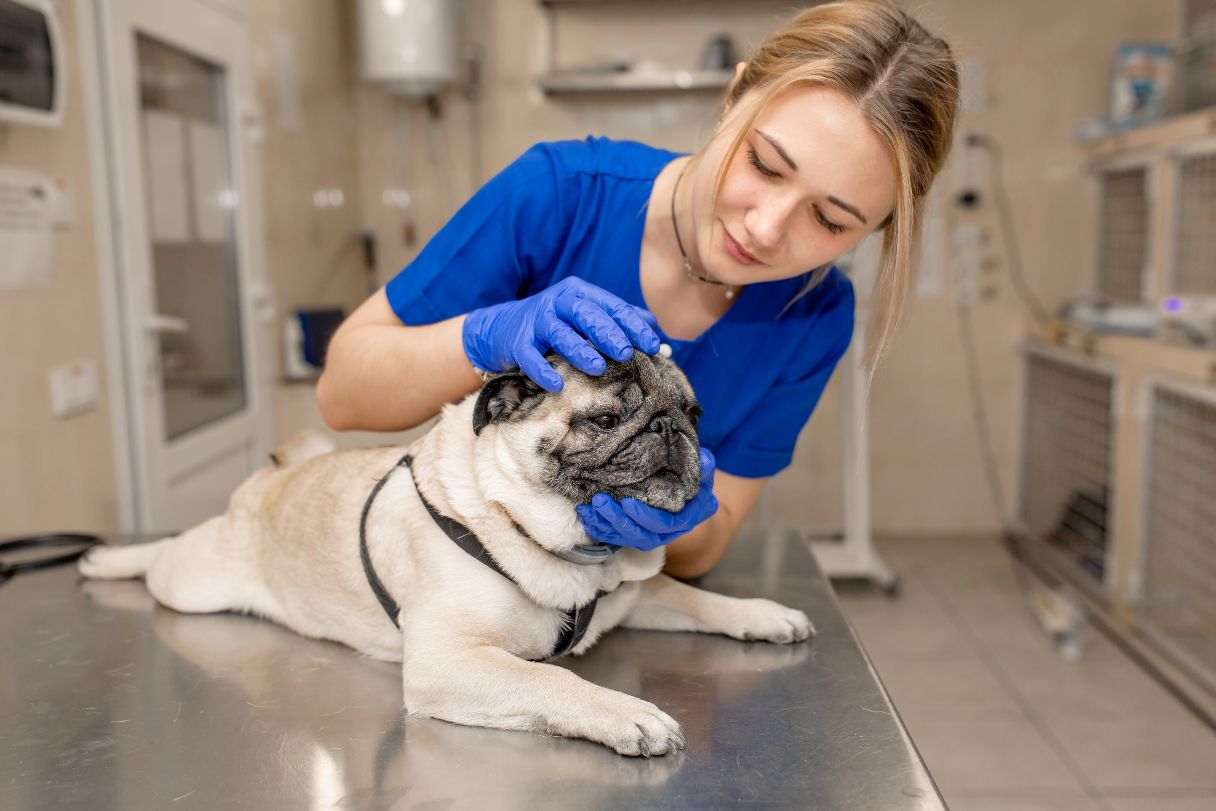If your dog’s ear is suddenly warm, puffy and itchy, don’t panic — but don’t ignore it, either. That squishy swollen lump could be a hematoma, and while it’s not life-threatening, it is very uncomfortable for your pup. Ear hematomas are more common than you might think, but they may require surgery to treat the condition quickly and effectively.
What Is a Hematoma?
A hematoma is a collection of blood within an organ or tissue that appears as a lump under the skin. Unlike a bruise, which is caused by bleeding within the skin, a hematoma occurs when blood pools outside of a blood vessel. Bruises are broken blood vessels, typically caused by accidents or bumps, while a hematoma is usually related to a more serious trauma.
In dogs, hematomas most commonly occur on their pinna, or ear flap. This is called an aural hematoma and can cause the entire ear or just a part of your dog’s ear to swell and appear thick and spongy. It is sometimes called cauliflower ear.
There are several causes of a hematoma:
-
Allergy
-
Bite wound or injury
-
Bleeding or clotting disorder
-
Excessive scratching or head shaking
-
Foreign material that may have been lodged in the ear canal and then later dislodged
-
Immune disorder
-
Infection
-
Yeast or bacterial infection
A hematoma can eventually be reabsorbed by your dog’s body, but ear hematomas, in particular, are painful and require treatment. Even if it is reabsorbed, the hematoma can cause trauma to your dog’s ear, resulting in scar tissue or even blocking the ear canal. If there is an underlying cause like an ear infection, nontreatment can cause more serious issues with your dog’s hearing down the road.
Depending on the severity of your dog’s hematoma, your veterinarian may recommend draining it, prescribing oral steroids, treating the underlying cause if it’s due to an infection, allergy, or foreign body or performing surgery.
How Much Does Dog Hematoma Surgery Cost?
The national average cost* of dog hematoma surgery can range from $535 to $1,230, depending on where you live, the size of your dog, the size and severity of the hematoma and other factors.1
Pet insurance may cover surgeries. In some cases, you need to have extra coverage for these procedures. If your pet insurance covers surgery, the cost to treat an aural hematoma averages $546.2
Dog Hematoma Surgery: How It Works
If your dog has been diagnosed with an ear or skin hematoma and your vet is recommending surgery, here’s what to expect from the procedure, including ways to prepare and what happens during surgery.
Preparation
Your dog will need anesthesia for this procedure, so your veterinarian will likely do a presurgery medical exam. They may also require blood work to make sure your pup is a good candidate for anesthesia. Your vet will give you specific instructions on prepping for the procedure, but typically, you won’t feed your pet after midnight the night before. Water should be available to your dog at all times.
Procedure
Surgery for dog hematoma typically involves three steps:
-
Drain the blood. Your vet will either make a small incision into the hematoma where a drain will be placed, or make an incision that completely opens the hematoma.
-
Close the space. In the case of an ear hematoma, the vet will place stitches completely through the ear flap to hold both the top and bottom layers of skin to the ear cartilage.
-
Stabilize the area to prevent further damage. Your dog’s ear may be wrapped with a bandage to prevent further damage while the incision is healing.
Possible Side Effects From Dog Hematoma Surgery
It is important to keep your dog’s surgical site protected so that it doesn’t get infected and so that the hematoma doesn’t return.
The most common side effect of anesthesia is that your dog may be tired and sleepy for 12 to 24 hours after anesthesia, but he or she may also experience:
-
Balance issues
-
Digestive upset (nausea or diarrhea)
-
Difficulty regulating their body temperature
-
Whining from being disoriented and not understanding what’s going on
These side effects should resolve themselves, but if you have any concerns or if any of the behaviors seem extreme (i.e., your dog is lethargic and/or nonresponsive), call your veterinarian for advice.
Alternatives to Hematoma Surgery
For decades, surgery has been the main treatment strategy for aural hematomas; over time, however, medical management strategies have also been found to be effective. Ask your veterinarian about other non-surgical options that may be effective, including but not limited to:
-
Treating the underlying cause. Managing any concurrent issues, such as ear infections or allergic skin conditions, is crucial for resolving the hematoma and preventing it from coming back. It’s worth noting that sometimes, simply monitoring the situation can be a valid approach, as many aural hematomas will heal on their own if the underlying causes are addressed.
-
Oral corticosteroid administration. Some hematomas can be treated with a tapering dose of oral corticosteroids alone. It is common to use a combination of systemic corticosteroids, draining the hematoma and injecting corticosteroids directly into the area for patients needing medical management.
-
Non-surgical drainage. Your veterinarian may attempt non-surgical drainage of aural hematomas, but it is usually more effective when combined with corticosteroid injections and/or systemic corticosteroid therapy.
-
Intralesional therapy. There are a variety of medications that some veterinarians will inject into the swelling. Most of these are anti-inflammatory medications that can reduce swelling and pain.
-
Intralesional triamcinolone and oral prednisolone. Some veterinarians will consider draining the hematoma, then instilling a long-acting corticosteroid into the space every seven days for one to three weeks. At the same time, your dog may receive an oral corticosteroid (given by mouth) at a dose based on their weight, given once daily for seven to 14 days, tapering off after a week. This approach can be to be quite effective.
-
Intralesional methylprednisolone. After draining, your veterinarian may use a short-acting corticosteroid injected into the hematoma space every seven days for one to three weeks.
-
Intralesional dexamethasone. Other veterinarians may instead instill a medium- or long-acting corticosteroid that has been diluted with saline into the hematoma space. This procedure is sometimes repeated every 24 hours for one to five days.
-
Intralesional platelet-rich plasma. This blood product can potentially accelerate the healing process by providing the ear with a variety of growth factors. This injection is typically given after drainage.
The Takeaway on Hematoma Care
While a dog hematoma isn’t life-threatening, it can be very painful for your pup and often requires veterinary care. Medical (non-surgical) management is effective in many cases, however if your veterinarian recommends surgery, it is something to consider.
Early intervention and treating the underlying cause of the hematoma may prevent hematomas from worsening, help them resolve faster and may prevent them from occurring altogether. If you notice a lump or swelling on your dog, contact your vet as soon as possible.
CareCredit Credit Card Financing for Dogs
The CareCredit credit card provides a convenient way to pay for your dog's vaccinations and other health and wellness expenses, including exams, medications and products at providers in the CareCredit network.** Continue your wellness journey by downloading the CareCredit Mobile App. You can find a provider on the go, manage your CareCredit account and easily access the Well U blog for more great articles, podcasts and videos. Use our Acceptance Locator to find a veterinarian that accepts CareCredit to help keep your pet healthy and happy for a lifetime of love.
In addition to pet care, you can also use your CareCredit credit card for dentistry, cosmetic, vision, hearing, health systems, dermatology, pharmacy purchases, spa treatments and so much more within the CareCredit network. How will you invest in your health and wellness next?
Expert Reviewer
Dr. Courtney A. Campbell, D.V.M., D.A.C.V.S.-S.A.
Dr. Courtney A. Campbell is a board-certified veterinary surgeon, specializing in orthopedics, soft tissue and minimally invasive surgery. His career extends beyond the operating room; he has emerged as a media personality, infusing his work with an innovative spirit of ‘edutainment’ — a delicate fusion of entertainment and education. Dr. Campbell has shared his expertise on numerous daytime talk shows and news segments, notably as the host of "Pet Talk" on Nat Geo Wild. Today, Dr. Courtney serves as an event host, a conference speaker and a clinical instructor at the Colorado State Translational Institute. He recently founded Stitches Veterinary Surgery, the first surgical specialty hospital in Long Beach, California.
Author Bio
Abbie Mood is a freelance writer with more than 15 years of experience. She has worked with clients of all sizes to create compelling content and she has written for the American Kennel Club, Marriott Bonvoy, Women’s Health Online, Headspace and more.







